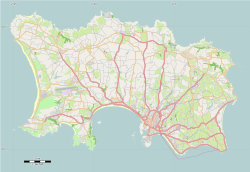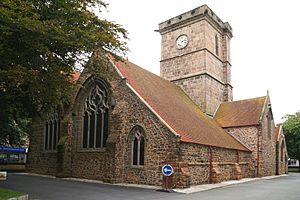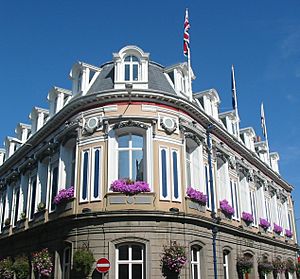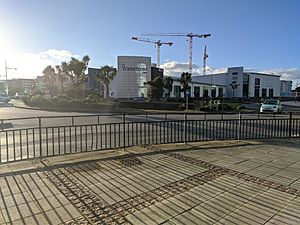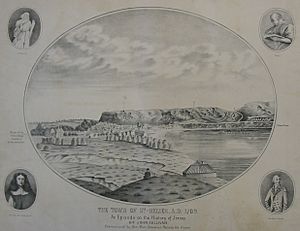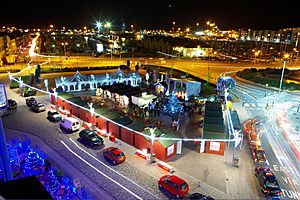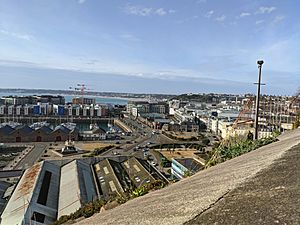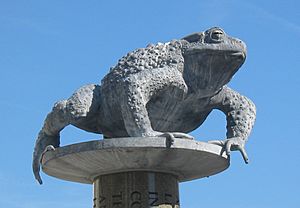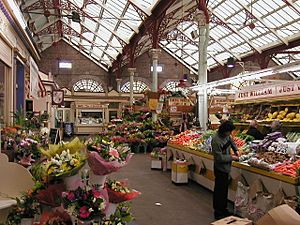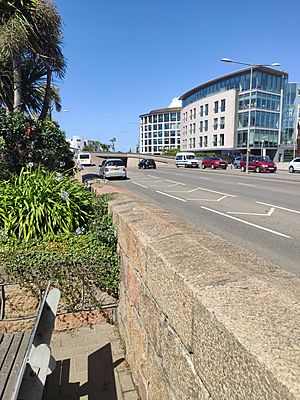St Helier facts for kids
Quick facts for kids
St Helier
|
|||
|---|---|---|---|
|
Jersey parish
|
|||
|
Panoramic, Saint Helier pilgrimage, Jersey Girl sculpture, Jersey Opera House, Cenotaph, war memorial of Jersey; King Street, Ferries, Elizabeth Castle, Houses in Saint Helier
|
|||
|
|||
| Nickname(s):
Town
|
|||
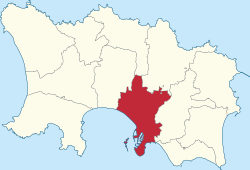
Location of Saint Helier in Jersey
|
|||
| Crown Dependency | Jersey | ||
| Named for | Helier, patron saint of Jersey | ||
| Vingtaines |
List
Vingtaine de la Ville
Vingtaine du Rouge Bouillon Vingtaine de Bas du Mont au Prêtre Vingtaine de Haut du Mont au Prêtre Vingtaine du Mont à l'Abbé Vingtaine du Mont Cochon |
||
| Area | |||
| • Total | 10.6 km2 (4.1 sq mi) | ||
| Area rank | Ranked 5th | ||
| Population
(2021)Bulletin 1: Population characteristics. In: Census 2021. Statistics Jersey (gov.je). Census taken 21 March 2021. Published and retrieved 13 April 2022.
|
|||
| • Total | 35,822 | ||
| • Density | 3,379/km2 (8,750/sq mi) | ||
| Time zone | GMT | ||
| • Summer (DST) | UTC+01 | ||
| Postcode district |
JE2
|
||
| Postcode sector |
3 and 4
|
||
| Website | www.sthelier.je | ||
St Helier (pronounced "HEL-ee-er") is one of the twelve parishes of Jersey. Jersey is the largest of the Channel Islands in the English Channel. St Helier is the island's capital and its biggest town. More than one-third of Jersey's total population, about 35,822 people, live here.
The town of St Helier includes its own built-up areas like First Tower. It also extends into parts of nearby parishes such as St Saviour and St Clement. However, a large part of the St Helier parish is still countryside.
The parish covers about 10.6 square kilometers (4.1 square miles). This is about 9% of Jersey's total land area. The town has grown a lot over time, often because many people moved to the island. The parish's coat of arms shows two gold axes crossed on a blue background. The blue stands for the sea, and the axes represent the death of Helier by Saxon pirates in 555 AD.
Contents
- Discovering St Helier's Past
- How St Helier is Governed
- St Helier's Location and Features
- People of St Helier
- Fun and Culture in St Helier
- Public Spaces and Parks
- Famous Places in St Helier
- Getting Around St Helier
- Places of Worship
- Future Plans for St Helier
- Partner Towns
- Sports in St Helier
- Famous People from St Helier
- See also
Discovering St Helier's Past
The Story of Saint Helier
St Helier gets its name from Helier, a holy man from Belgium who lived in the 6th century. He was killed in 555 AD. His special day, July 16, is celebrated every year with a walk to his old home, called the Hermitage.
Old stories about Saint Helier, the island's patron saint, suggest that the area was once a small fishing village. It was located on sand dunes between wet marshland and the sea.
In 1155, a religious building called the Abbey of Saint Helier was built on L'Islet. This was a small island next to the Hermitage that you could reach at low tide. When the Reformation happened, the Abbey closed. Later, a castle was built on its site. This new castle, Elizabeth Castle, became Jersey's main fortress. It was named after Queen Elizabeth I by Sir Walter Raleigh in the early 1600s.
How St Helier Began
The area where St Helier town now stands was once mostly low, wet marshland and sand dunes. There isn't much proof of people living here before history was written down. An ancient stone monument called a dolmen was found on Mont de la Ville (where Fort Regent is now). It was moved in the 1780s. People think St Helier was settled when the Romans controlled Gaul (ancient France).
Around 540 AD, the monk Helerius, who the parish is named after, lived on a small island in St Aubin's Bay. This island is now part of the parish and where Elizabeth Castle stands today. From his hermitage, Helerius helped convert the islanders to Christianity. He was killed in 555 AD while trying to protect the island from sea raiders. Because of this, his hermitage became a very important religious place.
Christianity brought new ways of governing the island by the late 900s, including the parish system. It's believed that the parish borders haven't changed much since then.
The first clear sign of a settlement in St Helier comes from records in 1229. However, the parish church, known as the Town Church, has parts that are at least 11th century old. Even though it's far from the sea now, it was built near the edge of the dunes, close to St Helier's Hermitage. Before land was reclaimed and ports were built, boats could tie up to the churchyard wall.
The first homes in St Helier were likely simple fishermen's huts along what is now Hill Street. They were probably made of granite with thatched roofs. There's also some proof of homes from the 12th century around Old Street. The Abbey and Town Church helped the village grow into the island's main town. Markets were held regularly from the 1400s, and the Royal Court (the island's main court) met in St Helier for a long time. The town was officially recognized by the Privy Council by the mid-1500s.
It's hard to know the exact layout of the medieval town's streets. A map from 1563 shows buildings clustered behind the Town Church. The Royal Square, which was the town's market, was surrounded by buildings by 1550. King Street and Queen Street were also established then.
St Helier grew in waves, often linked to people moving to the island. One early growth period was between the Reformation and the English Civil War. Many French Protestants came to Jersey seeking safety, especially after 1685. The town expanded west, with new streets like Hue Street and Dumaresq Street. By the early 1600s, the town included the Royal Square, Hill Street, King Street, and Queen Street. These two streets formed the main path through St Helier.
In the 1600s, improvements included building a wall around the Town Church cemetery. A prison was built over Charing Cross, and important streets were paved. In 1610, a court order made property owners pave the area in front of their houses.
St Helier in the 1700s
In 1700, the cattle market moved from Broad Street to the beach. This spot was about 60 to 100 yards southwest of the churchyard. It stayed there until 1841.
La Cohue, a Norman word for courthouse, was on one side of the Royal Square. It's now rebuilt as the Royal Court and States Chamber. The market cross in the square was removed during the Reformation. The iron cage for prisoners was replaced by a prison gatehouse at the town's western edge. Broad Street served as the coast road. Maps show the town became much denser between 1700 and 1756.
An early 18th-century account describes the town:
The Town in its present enlarged state, contains about 400 houses, laid out into several wide and well-paved streets. ... The Town is inhabited chiefly by merchants, shop-keepers ... and retailers of liquors; the landed gentlemen generally living upon their estates in the country. In short here is scarce anything wanting for necessity or convenience. Besides the stream running through the place [and literally under some houses] there is farther supply of good water from wells and pumps.
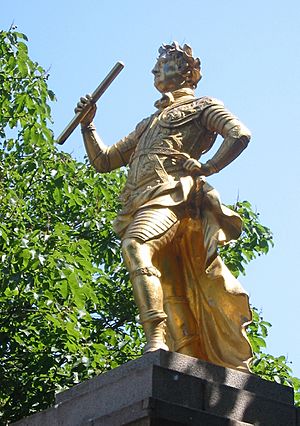
King George II gave £200 to help build a new harbor. Before this, boats would be left on the sand at low tide and unloaded by carts. A statue of the king was put in the square in 1751 to show thanks. The marketplace was then renamed Royal Square. Many of St Helier's street names are in English and French or Jèrriais.
The Royal Square was also where the Battle of Jersey took place on January 6, 1781. This was the last time French forces tried to take Jersey. After the French Revolution in 1789, thousands of French refugees, many of them nobles, settled in Jersey, mostly in St Helier. This doubled the number of houses in town.
As the harbor was built, the town expanded towards the sea. More people meant that marshland and fields north of the town were built on. English immigrants also added colonial-style townhouses to the traditional buildings. The ongoing threat from France led to the building of Fort Regent, a strong fortress on Mont de la Ville, which overlooks St Helier.
St Helier in the 1800s
Around 1800, the market moved from the Royal Square to a new, larger building at its current location. This shifted the town's main activity away from its old center. However, the old center remained important, with new buildings like Commercial Buildings near the waterfront. Military roads connecting coastal defenses to St Helier harbor helped farmers. They could use fast sailing ships and then steamships to send their produce to markets in London and Paris quickly. This started Jersey's farming success in the 1800s.
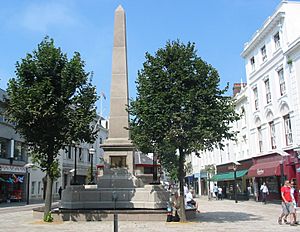
The Napoleonic Wars brought the threat of war to Jersey. The island was fortified against French invasion. Martello towers were built along the coast, including First Tower in St Helier. In 1805, the States (Jersey's government) agreed to sell Mont de la Ville to the British government for a major fort. Building the fort brought many people and money to the island, especially from Ireland and England. The States used the money from the sale to improve town pavements.
The early 1800s were a time of growing trade for Jersey. A British Custom House was set up in 1810. A big change for St Helier was the arrival of steamships. Before this, travel to the island was long and unpredictable. By the mid-1820s, the post office also started using steamships. The first paddle steamer visited Jersey on June 11, 1823. In 1824, two shipping companies started, offering weekly steamship services to England.
Thousands of passengers came to the town. By 1840, there were 5,000 English residents in Jersey. The number of English-speaking soldiers and retired officers, plus laborers, led to St Helier slowly becoming more English-speaking. This new immigration greatly affected local architecture. Many Georgian-style houses were built on the main roads out of town. The town also expanded with new streets, like Burrard Street, developed in 1812. In 1831, gas street lighting was first used on town roads.
St Helier's fast growth was one of the biggest changes in Jersey during the 1800s. The town grew from a small settlement to cover most of the parish. It even spread into St Clement and St Saviour. In 1776, St Aubin and St Helier were about the same size. But by the end of the 1800s, St Helier was much larger. It's thought that by the mid-1800s, there were 2,600 houses, 2,000 more than sixty years before.
An important development in the early 1800s was the building of the harbor. Before, ships only had a small jetty. The Chamber of Commerce pushed the States to build a new harbor. When the States refused, the Chamber paid to improve the harbor in 1790. A new breakwater was built to protect the jetty. In 1814, merchants built the roads now called Commercial Buildings and Le Quai des Marchands to connect the harbors to the town. In 1832, the Esplanade and its sea wall were finished. A quick increase in shipping led the States in 1837 to order two new piers: the Victoria and Albert Piers.
Pierre Le Sueur, a reforming Constable of St Helier, was responsible for installing sewers and providing clean water. This happened after outbreaks of cholera in the 1830s. A monument with a fountain was built in the town center to remember him after he died too young from overwork.
In the second half of the 1800s, many trucks full of potatoes and other goods needed access to the harbor. This led to roads being widened, which meant many old buildings in the town center were removed. Because of the need for new buildings, very few buildings in urban St Helier are from before the 1800s. This gives the town a mostly Regency or Victorian look.
Towards the end of the century, in the 1870s, the new Jersey Railway opened. It connected the town to the West, ending at the Weighbridge. A few years later, the Eastern Railway opened, ending at Snow Hill. By this time, the town had three parks: The Parade Gardens, Howard Davis Park, and People's Park.
The town's growth in the 1800s also led to more social facilities, especially churches. These 19th-century churches include St James' Church (1829), St Mark's Church (1843), Wesley Street Methodist Chapel (1827, rebuilt in 1876), and St Thomas' Catholic Church (1887).
St Helier in the 1900s
By the early 1900s, most large open spaces around St Helier were developed. New buildings were often built to make the most of the space. After the First World War, there was a need for new homes. With more cars, roads leading into the countryside allowed new buildings to spread out in all directions. In the 1930s, the States built Jersey's first public housing estate at Wellington Park.
After the German occupation of the Channel Islands, St Helier continued to change. This was due to more tourism and Jersey's role as a financial center. Cars led to a big increase in people moving around the island. This required wider roads and more parking. In the 1960s, money from the Jersey States Lottery was used to dig a two-lane road tunnel under Fort Regent. This helped traffic from the harbor reach the east coast towns without a difficult route around the fort.
Some important old buildings have been destroyed since the Second World War. This includes the Manoir de la Motte, one of the oldest townhouses. This led to a movement to save historic buildings. Now, there are stricter rules to protect the town's old architecture. Around the same time, Fort Regent was turned into a big leisure center. It was connected to the town center by a gondola cableway, which closed in the 1990s. In the 1970s, the central streets were made pedestrian-only.
St Helier in the 2000s
In 2006, there was talk of St Helier becoming a city.
An explosion at a block of flats in Pier Road on December 10, 2022, killed at least eight people. It was thought to be caused by a gas leak.
How St Helier is Governed
The Local Government
The Parish of St Helier has its own responsibilities. People vote to elect officials for the Municipality of St Helier. These officials, led by the Constable and two Procureurs du Bien Public, help run the parish. They are supported by a paid staff.
Five members of the Roads Committee and ten Roads Inspectors are also elected. They make sure the parish roads are in good condition. The Assessment Committee members decide how much tax each property in the parish should pay. The Accounts Committee checks the parish's finances. Like other parishes, St Helier has an Honorary Police force, which is made up of volunteers.
The parish is divided into areas called vingtaines for administrative purposes:
- La Vingtaine de la Ville
- Canton de Bas de la Vingtaine de la Ville
- Canton de Haut de la Vingtaine de la Ville
- La Vingtaine du Rouge Bouillon
- La Vingtaine de Bas du Mont au Prêtre
- La Vingtaine de Haut du Mont au Prêtre
- La Vingtaine du Mont à l'Abbé
- La Vingtaine du Mont Cochon
The Conseil Municipal
The Conseil Municipal is a new local council for St Helier. The idea for this council came up in 1892, but it wasn't until November 2019 that a trial council was set up. Its goal is to help the Parish achieve its aims.
It includes:
- The Constable
- The Procureurs du Bien Public
- Members of the Roads Committee
- One elected youth member
- Four other elected members
Representation in the States Assembly
St Helier is divided into three voting areas for elections to the States Assembly (Jersey's parliament). It elects 13 Deputies. The parish's Connétable (Constable) also sits in the States automatically.
| District | Vigntaines | States Members |
|---|---|---|
| Whole parish for Connétable | Simon Crowcroft | |
| North |
|
|
| Central |
|
|
| South | Vingtaine de la Ville |
|
Jersey's Capital
St Helier is the main town and the de facto (in practice) capital of Jersey. It's where the government and legal system are based. The States Assembly (the law-making body) meets at the States Chamber. This is next to the Royal Court, which is the island's highest court. Both are located in the Royal Square.
St Helier's Location and Features
St Helier is one of Jersey's twelve parishes and has the most people. It's on the island's south coast, at the eastern end of St Aubin's Bay. It includes most of Jersey's main town. A large part of the parish is still rural.
The town doesn't have a clear border and doesn't exactly match the parish boundaries. The built-up area includes much of the southern part of the parish. Most of the town is on low-lying land, including hills and a flood plain.
The town center is completely within the Parish of St Helier. It includes the area around the main shopping streets, King Street and Queen Street. It also has the Parade Cenotaph, Town Church, Town Hall, Royal Square, Victorian Market, the States Chamber, and Liberation Square. This area is the island's main business district, with most of the shops and financial companies.
The parish has a population of 33,522 and covers 10.6 square kilometers. This makes it the most densely populated parish on the island.
The parish has very different types of land. The marshland where the town sits is surrounded by higher land. These hills protect the town from strong winds. In the southeast, Mont de Ville and Mount Bingham rise from the plains. They separate the Havre des Pas area from the Harbour.
Le Grand Douet is a stream that flows underground through the parish from the north, near Grands Vaux, and comes out near the Underpass.
Since the 1980s, a big land reclamation project has expanded the southern part of St Helier. This area is now known as the Waterfront. The A1 dual carriageway was improved and extended, with a new grade-separated roundabout junction. This was the first of its kind in the Channel Islands.
Buildings and Design
The town is not very visible from the countryside because it's in a sheltered valley. The parish has several distinct areas:
- West Esplanade and Elizabeth Castle: This area has wide views of St Aubin's Bay and the sea. It's dominated by Elizabeth Castle.
- La Collette: This area is mostly reclaimed land surrounded by the sea on three sides. It's mainly industrial and has the tall chimney of the La Collette power station, which can be seen across St Helier.
- Havre des Pas: This is a very unique and pleasant part of town. It has mostly old buildings with a seaside feel.
- Fort Regent: Its shape is one of the most recognizable images of St Helier. It's an important landmark, a historic site, and a major leisure center.
- Old Harbours: This area has a distinct feel as a historic harbor, with open public spaces like Liberation Square. The piers and harbor structures were built in the early 1800s.
- New Waterfront: This area is mostly on reclaimed land. It looks different from the rest of the town, with modern buildings and a different street layout. It has a leisure center, modern apartments, offices, and green spaces.
- The Parade and Esplanade: This is the historic edge of the town. It has a mix of old, post-war, and modern buildings. It's home to the General Hospital and the Parade Gardens.
- Town Centre Core: This is the heart of St Helier, with pedestrian streets and public spaces. It also has many important landmarks.
- Town Centre North: This area is mostly residential. It's home to St Thomas' Church, Springfield Stadium, and the Millenium Town Park.
- Town Centre Edges and Slopes: This area has mostly suburban homes. A notable landmark here is Victoria College.
St Helier's Weather
St Helier has an Oceanic climate. This means it has mild, rainy winters and mild to warm, quite sunny summers. Winters are milder than in mainland Britain and Europe because of the ocean and the Gulf Stream. Snow and frost are rare. Summers don't get as hot as in England or mainland Europe during heatwaves, but the weather is often better with more sunshine and less rain. Rainfall is common in autumn and winter but less so in late spring and summer. July is the driest month. St Helier gets more sunshine than the UK and northern France, averaging 1950 hours per year.
January is the coldest month, with an average high of 9.4°C (49°F) and a low of 6.2°C (43°F). July is the warmest month, with an average high of 21.9°C (71°F) and a low of 14.5°C (58°F). St Helier also holds the record for the most sunshine in one calendar year in the British Isles.
| Climate data for Saint Helier 54m asl, 1991-2020 | |||||||||||||
|---|---|---|---|---|---|---|---|---|---|---|---|---|---|
| Month | Jan | Feb | Mar | Apr | May | Jun | Jul | Aug | Sep | Oct | Nov | Dec | Year |
| Mean daily maximum °C (°F) | 9.4 (48.9) |
9.3 (48.7) |
11.7 (53.1) |
14.4 (57.9) |
17 (63) |
19.4 (66.9) |
21.9 (71.4) |
21.9 (71.4) |
20.3 (68.5) |
16.3 (61.3) |
12.6 (54.7) |
10.6 (51.1) |
15.4 (59.7) |
| Mean daily minimum °C (°F) | 6.2 (43.2) |
5.4 (41.7) |
6.3 (43.3) |
7.7 (45.9) |
10.4 (50.7) |
12.8 (55.0) |
14.5 (58.1) |
15.0 (59.0) |
13.8 (56.8) |
11.7 (53.1) |
9.4 (48.9) |
8.0 (46.4) |
10.1 (50.2) |
| Average rainfall mm (inches) | 95 (3.7) |
72 (2.8) |
63 (2.5) |
55 (2.2) |
54 (2.1) |
50 (2.0) |
43 (1.7) |
52 (2.0) |
65 (2.6) |
105 (4.1) |
107 (4.2) |
110 (4.3) |
871 (34.2) |
| Average rainy days (≥ 1.0 mm) | 5.9 | 4.4 | 2.9 | 3.3 | 3.0 | 2.7 | 0.5 | 1.9 | 3.4 | 4.5 | 5.5 | 5.7 | 43.7 |
| Mean monthly sunshine hours | 70.3 | 116.0 | 170.8 | 198.9 | 268.7 | 242.9 | 278.8 | 255.0 | 192.4 | 127.4 | 89.6 | 72.4 | 2,083.2 |
| Source: Infoclimat | |||||||||||||
People of St Helier
St Helier is Jersey's most populated parish. In the 2011 census, it had 33,522 residents. By 2021, this number grew to 35,822.
| Historical population | ||
|---|---|---|
| Year | Pop. | ±% |
| 1991 | 28,123 | — |
| 1996 | 27,523 | −2.1% |
| 2001 | 28,310 | +2.9% |
| 2011 | 33,522 | +18.4% |
| 2021 | 35,822 | +6.9% |
Fun and Culture in St Helier
St Helier has many cultural places. These include the Jersey Museum, the Maritime Museum, the Jersey Opera House, and the Jersey Arts Centre. There's also the St James performance venue, sports and entertainment at Fort Regent, the Jersey Library, and the Jersey Archive.
The parish has hosted the Jersey Battle of Flowers carnival every year since 1902.
Public Spaces and Parks
The Weighbridge Area
The Weighbridge is a public space in the south of town. It has three squares, divided by La Route de la Libération and the Esplanade. The Weighbridge is famous as the place where Jersey was freed on Liberation Day. British soldiers raised the Union Flag at the Pomme d'Or Hotel, marking the end of five years under Nazi occupation.
In 1995, a sculpture was put up to celebrate 50 years of Jersey's freedom. It shows islanders raising the British flag, just like they did on Liberation Day. The circular shapes in the square stand for freedom. A moat around the statue represents the sea, and twelve parts represent the parishes of the island.
This area is on land that was reclaimed from the sea. The first weighbridge was built here in 1825. The Jersey Railway station opened here in 1870. A statue of Queen Victoria was once here but is now in Victoria Park. This area was also the island's main bus station until Liberation Station opened in 2005.
The Parade Gardens
The Parade is a large open area in western St Helier. It has a park in the center and roads around it. The Cenotaph (a war memorial) and the General Hospital are located here. In Jèrriais, it's called Les Mielles, meaning sand dunes.
It was originally a training ground for soldiers. The first hospital building was finished in 1768 but was used as barracks at first. The Cenotaph was built in 1923 to remember islanders who died in the First World War and later the Second World War. It's the main place for Remembrance Day celebrations on the island.
Millennium Town Park
This is St Helier's newest park, opened in 2013 on a former car park site. Its creation was planned in 2000, but it was delayed due to lack of money. The park has water features, sculptures, a playground, and an area for ball games. It also has a cycle path.
The park has helped improve the local area, with new buildings like Merchant's Square nearby.
Charing Cross Square
Charing Cross is a square at the western end of King Street. It was once the site of a prison in the 1600s. There is a monument of a Toad (called "Le Crapaud"). It was put up in 2004 to celebrate 800 years of Jersey's loyalty to the English Crown. Across the road is La Croix de la Reine, a cross built to celebrate the Queen's Silver Jubilee in 1977.
St Andrew's Park
St Andrew's Park is located around St Andrew's Church in First Tower. It was given as a gift in 1911. Two very old stone monuments called neolithic dolmens, dating back to 2800 and 2300 BCE, can be found here.
Famous Places in St Helier
Many places in St Helier are officially listed as Sites of Special Interest by Jersey's Planning and Environment department.
Elizabeth Castle
Elizabeth Castle is a 16th-century castle on a tidal island off the coast. It was built to add to the defenses of Mont Orgeuil in St Martin. It is now a museum and tourist attraction, managed by Jersey Heritage. You can reach it by a causeway at low tide. When the tide is high, a special duck ferry takes visitors there.
Fort Regent
Fort Regent is at the top of Mont de la Ville. It was first built as barracks at the end of the Napoleonic Wars. In 1967, it was decided to turn it into a leisure complex. There used to be a cable car that went up to Fort Regent from Snow Hill, but it closed in 1991. A swimming pool that opened in 1971 was taken down in 2020.
A tunnel (A17) was opened under the Fort on February 25, 1970, after seven years of building. This tunnel connects traffic from the east to the west of the island. It also helped make the town center more pedestrian-friendly.
Central Market and Beresford Market
Central Market, on Beresford Street, St Helier, is an indoor market that opened in 1882. It's an official Site of Special Interest and is popular with both tourists and locals. It features Victorian architecture with cast iron structures and a decorative fountain in the center. The market was designed by Thomas Helliwell.
The market has stalls selling flowers, fruit, and vegetables, as well as small shops and cafés. Beresford Market is a separate building next to the Central Market that specializes in selling fish.
16 New Street
This is an 18th-century Georgian townhouse that has been restored by the National Trust for Jersey. It now operates as a museum.
Getting Around St Helier
The main roads in the parish include the St Helier Ring Road and other major roads that connect to nearby parishes. A road tunnel under Fort Regent links the west and east sides of the island.
The parish is responsible for maintaining smaller local roads, managed by the Roads Committee. The government is in charge of the main roads.
The parish has Liberation Station, which is the main bus station for the island's public transport. Every bus route on the island ends in St Helier, connecting it to every other settlement. Some bus services go directly to Jersey Airport in St Peter. In 2022, the TownLink service started, providing local bus service within St Helier.
St Helier also has Jersey's main port. From here, you can take ferries to Saint-Malo in France, and Poole and Portsmouth in England.
Places of Worship
The parish church, known as the Town Church, is St Helier's oldest building. It's on Church Street, across from the Royal Court. It was built before the Battle of Hastings (1066) and has been changed many times. After the Reformation, it became a Huguenot (French Protestant) church. The Rector of the Town Church is usually also the Dean of Jersey. King Charles II attended services here.
As the town grew in the 1800s, more Anglican churches were needed, especially for English services. St Mark's Church on David Place opened in 1844. St Andrew's Church at First Tower started as a mission for sailors in 1850.
The St Helier Methodist Centre on Halkett Place was built in 1847. There were several other Methodist churches. In 1956, the French and English Methodist Churches joined together. In 2000, all Methodist congregations in St Helier moved to the Halkett Place Chapel. St Thomas' Catholic Church, also known as the French Church, is the largest Catholic church on the island. Its 1887 building is a beautiful example of French Gothic architecture. There are also Polish and Portuguese chapels for the island's Catholic immigrant communities.
Future Plans for St Helier
The Waterfront (Quartchi du Hâvre) area of St Helier is on land reclaimed in the 1980s. There have been many plans to develop this area. The current plan, from 2019, aims to make it safer and easier for people to walk across La Route de la Libération (a wide road in the area). It also wants new buildings to have good landscaping and a mix of uses, including community facilities.
The Jersey Development Company, which owns much of the land, is managing the redevelopment. As of June 2021, plans include taking down the current Waterfront Centre buildings. They also plan to redesign the Jardins de la Mer and Waterfront Gardens parks. New public squares and new traffic crossings will also be created.
Partner Towns
St Helier has special partnerships with these towns:
 Funchal, Madeira, Portugal
Funchal, Madeira, Portugal Avranches, France
Avranches, France Bad Wurzach, Germany
Bad Wurzach, Germany Trenton, New Jersey, United States
Trenton, New Jersey, United States
Sports in St Helier
The parish has many sports facilities. These include Springfield Stadium (with the island's football pitch), Aquasplash (a swimming pool), pétanque pitches, badminton courts, and the Fort Regent leisure center. Motorsports events happen on roads in the parish. There's also an annual Town Criterium (a cycling race) and the start and finish of the Jersey Marathon.
In 2021, the Government of Jersey released a plan called Inspiring Active Places Strategy. This plan will cost about £100 million. It suggests moving sports facilities out of Fort Regent by early 2022 because the building is old. The report says Fort Regent is not the best place for health and fitness for St Helier residents. So, temporary facilities will be needed for sports moving from Fort Regent.
Springfield Stadium will be updated to offer better public sports facilities and a new town park. The single stadium pitch will be replaced with two smaller 5-a-side pitches by 2026/27. However, some parts of Springfield will be redeveloped for more parking in the meantime.
The plan also includes building new facilities to replace those at Fort Regent. By 2030, a new leisure center will be built in the town center, where the Waterfront Centre is now. This new center will have a large swimming pool and a big health and fitness area. It will replace Aquasplash and the current fitness facilities at Fort Regent. Because it's in a busy town center, there's a chance to build homes above the new facility.
Famous People from St Helier
- Sir George Carteret (born 1610), a royal statesman and slave trader. He was the first owner of the British colony of New Jersey. He was born in St Helier.
- John St Helier Lander, an artist.
- Henry Cavill (born 1983), an actor famous for playing Superman and Geralt of Rivia in The Witcher.
- Henry Poingdestre (1832?–1885), a New Zealand farmer and unique person, born in St. Helier.
- Vaughn Toulouse (born Vaughn Cotillard; 1959–1991), a British singer and founding member of the bands Guns for Hire and Department S. He was born in St. Helier.
See also
 In Spanish: Saint Helier para niños
In Spanish: Saint Helier para niños
- Beaulieu Convent School
- Victoria College, Jersey
- Maritime history of the Channel Islands













